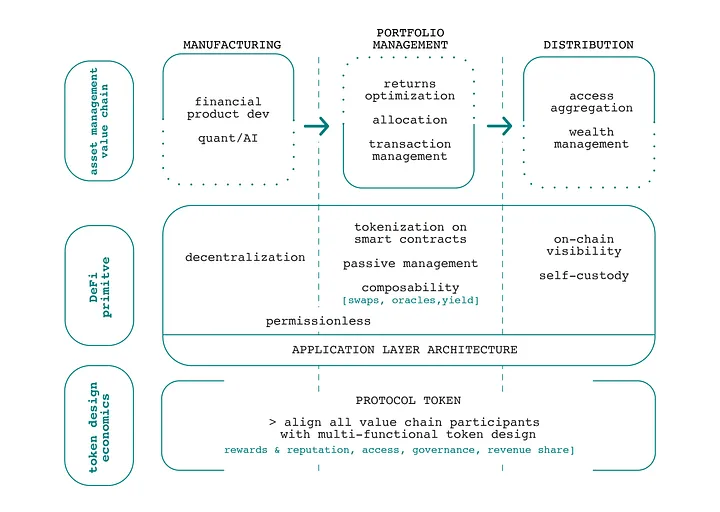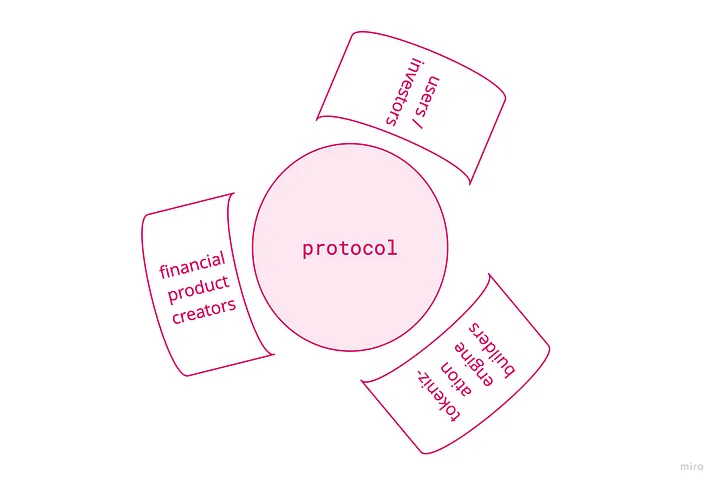Originally published at https://medium.com on Jan 17, 2023.
It’s no longer BAU in crypto. A protocol level web3 native asset management approach is critically essential for managing the financialization layer of crypto and managing financial value creation & systemic risk for users & investors in this participative asset class. I explore a framework for a decentralized on-chain asset management ecosystem where the protocol becomes a multi sided platform with three participant groups, and effectively decentralizes each component of the crypto financial value chain. The blockspace for creating the on-chain Charles Schwab of web3 is open — are we ready?
The transaction (utility) and financialization layers of crypto run together. That’s what fundamentally sets this foundational technology apart and underpins a tokenized economy. The transaction layer refers to the technology that handles the transfer of value between participants. This includes the process of creating, verifying, and recording transactions on the blockchain. The financialization layer includes the use of blockchain-based financial instruments, such as cryptocurrency and smart contracts, as well as the development of new financial products and services that are built on top of the blockchain.
A protocol level web3 native asset management approach is essential for managing the financialization layer of crypto and managing diversification & isolation of systemic risk for participants in the ecosystem.
Whilst the application of blockchain & crypto keeps advancing, and while scaling solutions for efficiency & security, and also tooling infrastructure for wider utility, continuously grow & garner focus; ultimately, the greater risk to wider adoption of the technology is arising from not managing the opportunity and exposure from its financialization layer.
A succession of systemic failures in crypto in the recent past have arisen from the way it is financially managed as an asset (or mismanaged), not functionality or transaction failures. And each time it has been a centralized entity that has been at the centre of this failure: From FTX (centralized exchange) going insolvent, to the saga of 3AC (hedge fund — centralized), Voyager (centralized lender), Celcius (centralized crypto platform) — all over-leveraged and un-transparently over-exposed to Luna. More recently, DCG closing down its wealth management, which reportedly had $3.5bn in assets at one time.
> Decentralized asset management
The take is simple — crypto at scale needs technofinance primitives for decentralized technology aligned asset management. Centralized operating financial entities are structurally incompatible in blockchain, which is a fundamentally decentralized & trustless technology. Crypto is not just finance, its utility function makes it a participative asset class.
A protocol level design for decentralized asset management must address two aspects clearly: the first is to build into the financial management primitive core blockchain architectural dimensions of decentralization, composability, on-chain provenance, & tokenization (of product & process). The second aspect is the application of this design across the crypto financial management value chain — starting with financial product manufacturing, fund (asset) management, quant interventions, to portfolio construction, advisory & wealth management, right up to distribution, custody, information & access management.
> Crypto financial value chain vis-a-vis DeFi architecture

A protocol design which combines a platform approach to investment management with a decentralized & tokenized architecture to the crypto financial value chain, and utilizes a multi-function protocol token to address mechanism design can provide an asset management solution for the majority of crypto users and investors. The protocol token will align process & participants through the value chain
Let’s look at crypto’s financial value chain from a systems perspective as three different processes or sub-platforms. First, as a fund management platform for bringing together distributed knowledge of crypto as an investment asset class. As a nascent asset class, the expertise of crypto investments is not organized. Available but unorganized. That’s the gap centralized hedge funds (with no hedge), centralized asset managers with balance sheet lending & borrowing (with scant collateral risk management) have pretended to fill up. A decentralized fund management platform will address this need for experience & expertise, and product development. Added to this, a quant based approach leveraging the full spectrum of on-chain metadata will bring in the power of information available in an open distributed ledger to fund management & product creation. Decentralized contribution to data and AI algorithms with incentive alignment will converge investment & data expertise.
The distillation of this distributed expertise capture for financial product strategies needs to be coded into smart contracts and not be centralized in the execution of capital management. And this would be the tokenization platform at the center of the value chain, and will leverage composability in blockchain technology to execute investment products via decentralized capital management. Composability will enable on-chain execution and also designing diversified & complex investment products built on other specific financial optimisation protocols (for eg staking or perpertuals) tokenized into single units which are managed autonomously by code, or by distributed consensus.
The subsequent component of the value chain, which processes direct interaction with users must be non-custodial in architecture. And also bring in complete on-chain visibility of assets and investment strategies & risk management frameworks of the tokenized product. It would be permissionless, enabling democratized to access the protocol’s output.
Purpose Driven Businesses
In effect, the protocol becomes a multi sided platform or market with three participant groups. The product creation and fund management side, the user or client side, and the tokenization side. The three groups form the community of the protocol and come together to participate in it’s governance — which in turn covers all dimensions of the value chain, and participate in the economic value creation of the protocol and by the protocol.
The token mechanism design of the protocol emerges from the role and utility of each of the three sides of the platform. A well designed multi-function protocol token will then drive the tokenized value creation, alignment, & participation and address incentive alignment, reputation & risk, access and governance.
> Decentralization of alpha, not decentralization of loss
The absence of web3 native wealth management primitives, and the centralization of web3 asset management have together contributed to the decentralization of losses! Crypto’s ethos must compel us to revisit decentralization fundamentals & yet leapfrog us to find a new way to democratize wealth creation in the tokenized economy, by changing the way people interact with this economy and how it is accessible intelligently to everybody.
Asset management in crypto needs to be on-chain and decentralized. It can’t be partial — like say non-custodial wealth management, but advised centrally by an opaque team and process whose incentives may be misaligned. Crypto and the larger Web3 ecosystem, as a technology and as an asset class needs wider and risk-adjusted adoption for it to sustain and flourish. This will be possible with systems thinking led pervasive decentralization as a foundation for the financial value chain in crypto.
The blockspace for creating the decentralized on-chain Charles Schwab of Web3 is open.

